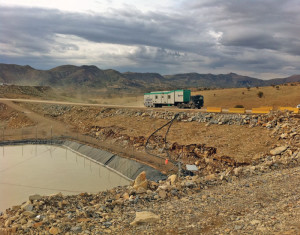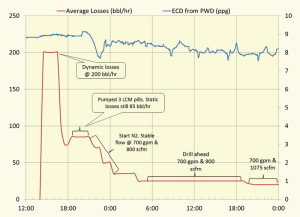OMV deploys first continuous circulation system in northern Iraq
Case study: Foam systems minimize losses in difficult well, custom 40-in. RCD enhances rig up, down safety
By Martin Cullen and Clayton Christensen, Blade Energy

Exploration wells drilled in the southern flank of the Zagros Range Fold Belt in northern Iraq are subject to major fluid losses. The limestones and dolomitic limestones, which form the upper portion of the folded structure, have well-developed karstic features and percolating water enlarged joint-fracture systems. This generation of open subsurface spaces is associated with the varying depth of the present and past water table.
The uppermost carbonate formations, where the karstic features are encountered, have been formed post-glacial. These structures are associated with a fluctuating water table and formed gradually by the dissolution of CaC03. They can be of considerable size and extent. A cavern in excess of 19-m vertical thickness was encountered during drilling operations in 2012.
Karst developments in the upper carbonate sections do not have any associated formation pressure regimes, and the use of a liquid-phase drilling fluid consequentially results in total losses. Drilling 36-in. and 26-in. diameter upper sections inherently presents challenges in obtaining adequate fluid rates to establish minimum hole-cleaning annular velocities. The combination of extensive subsurface karst features and large hole sizes presented a challenge to create an alternative solution to facilitate a safe and efficient drilling operation.
The intermediate sections lie below the influence of the water table and are primarily composed of dolomite and dolomitic limestones, with interbedded layers of claystone and anhydrite. The lower lying rocks have developed joint-fracture systems that, post-diagenetically, have been partially or fully sealed. Such fractures that are not fully sealed have the capacity to accept major amounts of fluid when subject to a hydrostatically overbalanced condition. Considering these formations are subpressured, this can pose significant challenges to a conventionally designed drilling program. The lower hole sections were potential hosts to further fracturing systems in an overpressured reservoir of an uncertain gradient.
Previous operations
OMV, operating in Erbil, Kurdistan, was posed with these geological challenges in the Bina Bawi Block. In 2011, OMV drilled Bina Bawi 3 (BB3) using a foam system for the top-hole sections. The intermediate and reservoir sections were drilled underbalanced. Underbalanced drilling (UBD) was identified as a key technology to prove the presence of mobile hydrocarbons.
Drilling BB3 had its operational problems. While drilling top hole with foam and a rock bit, the pipe became stuck in the hole due to cuttings accumulation, and the bottomhole assembly was lost. A UBD package used for the hydrocarbon-bearing zones included a rotating control device (RCD), nitrogen-generation unit, a choke manifold, horizontal separator and drilling fluid tanks. While drilling underbalanced, the team not only verified the presence of hydrocarbons but also found that hydrogen sulfide was present in the reservoir. An incidence of hydrogen sulfide release occurred on the location but was quickly controlled. No injuries occurred.
In light of these two issues, OMV and Blade Energy took a modified approach for wells planned in 2012 and 2013.
Planning the next well
During the planning of drilling operations for Bina Bawi 4 (BB4), it became apparent that OMV was open to using nonconventional drilling technologies to address the challenges. For the large top-hole sections, OMV procured a full air-generation package facilitating the use of foam. The team believed that cuttings settling in the hole during connections could have caused the stuck pipe event faced in BB3. To address this, continuous circulation technology was used.
The continuous circulation equipment made use of a drillstring-mounted circulating sub with a side entry port. One of these was placed on top of each stand, and prior to making a connection, the drilling fluid was diverted away from the standpipe to the side entry port of the sub through a high-pressure hose. It was then directed down the drillstring and back up the annulus.

This allowed for circulation during what would normally be a pumps-off event. This top-hole package retained the ability to pump an aerated mud as the drilling fluid, which would serve as the contingency plan. For the 36-in. and 26-in. hole sections, both rock bits and hammers bits were prepared. Hammer drilling was the primary approach in attempts to increase the rate of penetration.
For the intermediate zones (sections III and IV), which were potentially hydrocarbon-bearing, the previous UBD approach was not used due to the potential presence of a high concentration of hydrogen sulfide (up to 24%).
The desire was to keep these formation fluids in the reservoir by maintaining an overbalanced condition. Subhydrostatic zones could be encountered, however. If massive losses were encountered, the nitrogen-generating package would initiate a two-phase flow regime, reducing the bottomhole pressure below a normal gradient of 8.34 ppg yet maintaining a slight overbalanced margin. This would reduce the losses to a manageable level and keep the hydrocarbons and any hydrogen sulfide in place. Further discussions highlighted that, if the fractures encountered were substantial enough, this slight overbalance may induce unmanageable losses.
A contingency plan was developed to drill with mud cap techniques. Due to the subpressured nature of these hole sections, the mud cap operation would take place with continuous total losses, requiring a large amount of water as the mud cap fluid. This introduced logistical challenges in supplying the water, which was addressed by preparing additional reserve pits and arranging extra trucks for hauling fluid. At this stage of planning, the two lower sections (V and VI) were drilled conventionally.
Other technologies planned for potential use in the operations were:
• Use of drilling with casing to extend a casing-setting depth.
• Opening up one of the managed-pressure-drilling (MPD) hole sections via underreaming with two-phase flow.
• Use of either an electromagnetic or a digital pulse measurement-while-drilling (MWD) tool.
Neither of the MWD tools provided an ideal solution. The use of a pulse tool in a two-phase flow environment could compromise signal quality, and an electromagnetic MWD tool could experience failures after drilling through a layer of anhydrite. The presence of anhydrites and the use of two-phase flow were both possibilities for BB4.
Prior to commencing operations, Air Drilling Associates and OMV worked to build a fit-for-purpose, low-pressure RCD. Other operators in the region were drilling 36-in. holes with 30-in. RCDs. This restriction required creative rig-up techniques. Taking the design of the 30-in. RCD and applying it to a 40-in. clamp, a 40-in. RCD was fabricated and introduced to the region.
Drilling BB4
While drilling the 36-in. hole on BB4, the foam system – coupled with the hammer assembly and continuous circulation equipment from Managed Pressure Operations (MPO) – were deployed. All connections on this hole section were successful, and an average of 8.23 min was added to the connection time. However, there is hidden time saved when using continuous circulation equipment while drilling with foam or two-phase flow. With these multiphase fluid systems, once flow is stopped and re-initiated, it takes time to re-establish a stable flow regime. Having continuous flow eliminates this. In contrast to BB3, no stuck pipe events were noted on this section.
Even while drilling with a foam mud system of approximately 2 ppg density, in section I (36-in. hole), total losses were intermittently observed. After reaching section TD and failing to run casing to depth, OMV deployed a camera downhole. It was observed that the hammer bit had been lowered through a 19-m thick cavern, explaining the intermittent fluid returns. The 30-in. casing was eventually landed out 100 m short of section TD. To secure the casing in place, fluid-sensitive swelling pellets were deployed, followed by a cement job conducted from the top.
The subsequent 26-in. hole section was drilled with the same approach. Both hammer and rock bits were used, with the hammer bit exhibiting an ROP up to twice that of the rock bit. The MPO Non Stop Driller system had a connection success rate of 94.4%, with an improved average connection time of 6.63 min. After a failed attempt at drilling with casing to extend this section depth, the casing was run to bottom without issue and cemented via running a basket and conducting a top job. Once the water table was encountered, attempts were made at drilling with aerated mud, but all attempts resulted in a total loss of circulation. Drilling returned to a foam system of compromised quality due to the formation water. Thousands of barrels of water were produced until the reserve pits were full. Operations had to stop intermittently to handle the excess fluid at surface.
For the upcoming sections III and IV, the multiphase MPD package was mobilized. This consisted of a semi-automated PLC-controlled choke manifold, a horizontal separator, a closed-loop drilling system, an RCD and nitrogen-generating units to accompany the air compressing package. Reform Energy Services supplied the choke manifold and separation package. The initial plan was to demobilize the MPO Non Stop Driller package prior to section III. However, after seeing the benefits of its use for hole cleaning and in maintaining a stable flow regime, OMV elected to make use of it again.
Section III commenced conventionally with an 8.9-ppg water-based fluid. A total 200 bbl/hr losses were observed after a fracture was crossed. Three pills of lost-circulation material were pumped, and no reduction in the static losses was observed. To address this, multiphase MPD was initiated. Once online with a bottomhole pressure of approximately 8 ppg, the dynamic loss rate was reduced to 20 bbl/hr – 10% of the loss rate seen while drilling conventionally. The team elected to use the electromagnetic MWD tool. As the anhydrite was penetrated, the signal started to fail intermittently.

Section IV was again initiated in conventional drilling mode, with water-based mud at 8.9 ppg. No losses were observed while drilling this hole section, thus there was no requirement for multiphase MPD. The operation did call for an unplanned use of applied backpressure MPD. At section TD, the presence of background gas indicated the requirement of an increase in mud density prior to tripping out of hole.
The team realized the benefits of having a drilling choke in place in this scenario. The choke was used to apply backpressure, increasing the bottomhole pressure incrementally, followed by full circulations. This facilitated trip mud density determination and finalization with one mud density increase and one final displacement. Conventionally, this may have required more than one such procedure. This hole section was opened up with the underreamer. As no losses were observed, there was no opportunity to operate the tool in a two-phase flow regime.
As mentioned, sections V and VI were drilled without any MPD technologies. OMV, appreciating the benefit of the RCD as a barrier to the rig floor and the flexibility of a drilling choke, elected to retain this package on the current well and instructed Reform Energy to mobilize a second package for upcoming operations. Unfortunately, timing on deliverability of the second package did not allow all of BB4 to be completed with a choke. The first package was rigged out and sent to the next location.
Conclusions
BB4 was drilled through Karstified carbonates using multiple technologies. It was the first deployment of a continuous circulation system in the region. MPO’s connection success rate improved from approximately 95% on the first well to 100% on the second, and hole cleaning was not an issue. A 40-in. RCD was fabricated to enhance safety of the rig-up and rig-down procedures. The foam systems were successful in cleaning the hole and minimizing losses in such extreme conditions. The use of a hammer bit saw rates of penetration up to twice that of the rock bit.
For the intermediate sections, multiphase MPD assisted the team to reach TD safely and with reduced losses. It kept the well in an overbalanced state and did not permit hydrogen sulfide to surface. The choke was also used to execute applied backpressure MPD with a single-phase drilling fluid such that the required fluid density to trip out of hole could be determined safely and quickly.
One of the biggest successes was OMV’s maturing view of MPD. During planning, the benefits of continuous circulation were seen for the top-hole sections. Those benefits then became apparent for the intermediate sections. OMV retained the package for the multiphase MPD sections.
Through planning and discussions, OMV realized that deployment of a mud cap drilling operation could address extreme loss-circulation conditions and made the provisions to facilitate this as a contingency plan.
During section IV of BB4, OMV used the drilling choke in an unplanned manner to execute applied backpressure MPD. It also decided to retain the package for sections V and VI. All of this was summed up in one line stated by the OMV drilling manager: “In the future, I think that all wells will be drilled with an RCD and a drilling choke.”
This article is based on a presentation from the 2013 IADC/SPE Managed Pressure Drilling & Underbalanced Operations Conference, 17-18 April, San Antonio, Texas.




